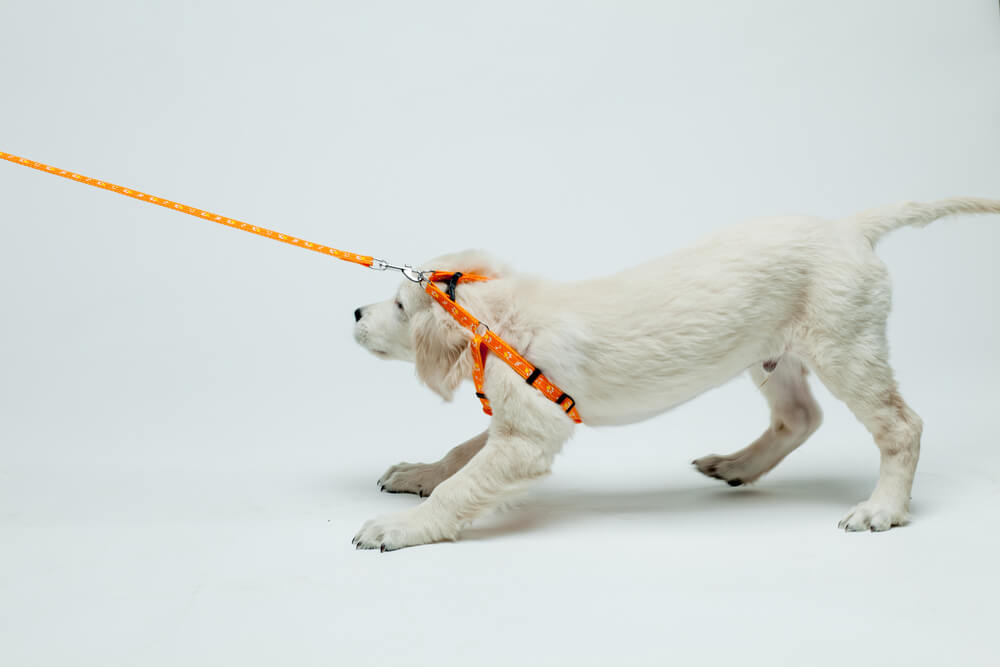Hey Ollie blog readers! We’re offering you an exclusive 60% OFF your starter box! Try now!
You know you need to walk your dog regularly. Not just to give them an opportunity to relieve themselves but also to give them exercise. Some dogs may even join you to run errands around town or take a walk to a local park. What happens when your best friend decides they don’t want to walk?
The answer all depends on why your pet might not want to walk with you. The sooner you can figure out what is going on, the easier it will be to resolve the issue. Consider these reasons your dog may not want to walk:
4 reasons why dogs refuse to walk
There are a number of reasons why a dog may not walk. Jessica Lempert, CPDT-KA, a trainer with Philly and South Jersey Unleashed explains, these four common reasons why and what to do about them.
1. They are uncomfortable
One reason your pup might not want to walk is that he is physically uncomfortable. Start by checking the fit of your collar or harness. Is something pinching your pet? If you use a harness of any type, make sure your dog’s mobility isn’t limited. If you have any cold or wet weather gear on your dog, like a jacket, raincoat, or protective boots – check to make sure they are fitted correctly and your pup is comfortable. When introducing new collars, harnesses, or protective gear, Jessica suggests that you let your pup try it on in the house and get comfortable. If straps or buckles are pinching or scratching, your pet might not want to walk!
2. They are scared
If your dog is freezing in place on the sidewalk or refusing to go, they might be scared. Some dogs don’t like to walk by bikes, skateboards, or can even be fearful of strollers, other dogs, or obstacles in their paths.
You might also see this in a rescue dog. Jessica says some rescue pups may have PTSD from something that happened before. If your rescue pup is scared of cars, maybe they were hit or had a close call before you got them. It might take you some time to figure out and work through all the things your pet is scared of. This could include men, children, other dogs, larger dogs, or even things like fountains, trash cans, or plastic bags – especially on a windy day. Once you’ve started to identify the things that are spooky, you’ll be able to better help your pet work through the fear.
If you’ve recently made a move from the suburbs into a bigger, busier city, the sounds may make your dog nervous. This could also be true for a dog you adopt from a shelter; the change in surroundings can be overwhelming. While in a suburban neighborhood, your pup may see cars or bikes, they might be closer to them in the city. There are also more people walking around, new sounds and smells, and maybe even new objects like scooters, strollers, or skateboards. Your dog may be nervous about the new surroundings and refuse to walk. You might even see your pup hiding in corners or doorways to get out of the traffic.
3. They are in pain
If your pup is suffering from knee pain, back pain, or injured paws, they might not want to walk far. If you suspect that your dog is injured or in pain, seek medical treatment immediately. Look for signs that your pup isn’t putting weight on all their feet, is limping or any other signs of physical discomfort.
Once the issue has been diagnosed, your vet may ask you to limit walks to just a short potty break or show you some corrective exercises to help your pet heal. Follow their instructions carefully so your pet can get back to walking with you ASAP.
4. They don’t want to leave
If this issue seems to pop up only when it is time to go home from the dog park or out for a walk in the rain, your pup might be trying to tell you he doesn’t want to go! If this is the case, you might see your pup lay down, or run away from you. If they’re still off the lead at the dog park and you’re trying to leash up and go home. This can be a tricky one. You could try working with your pet on recall skills (coming when called) and then asking for another trick or behavior before you leash them up. This way, they won’t avoid you when it is time to leave the dog park as a recall doesn’t always mean time to go.
What to do if your dog refuses to walk
Once you have an understanding of why your dog is refusing to walk, you can start to work on a solution for the problems. Jessica recommends:
- Always bring high value treats on a walk
“You want your dog to think that walks are a good and fun thing,” Jessica says. Choose a treat your dog really enjoys like cheese, lunchmeat, or even some peanut butter or almond butter. When you see behaviors you like, reward them at the moment. This could include walking through a crowd, not pulling, or even staying calm while a bike or skateboard goes by. If you do this consistently, you’ll help your dog understand what to do on a walk.
- Call in reinforcement when detecting severe anxiety
“If your pet is dealing with fear or anxiety, don’t try to self diagnose,” Jessica recommends finding a certified trainer who uses positive reinforcement and fear-free methods to help you help your dog. A trainer will be able to help you customize a plan to get your dog walking confidently! You will need to continue to practice the skills your trainer shows you. The issues will still take time to fix, and you’ll need to work with your dog consistently to see improvement. Be patient and work with your trainer – it’s okay to be honest about setbacks. Your trainer is there to help!
- Bail if something is really scary
If your dog is terrified of skateboards or hates walking by big crowds or loud sounds, it’s okay to turn around and walk the other way. You should not force your dog to walk by things you know they hate. While you’re probably not going to be able to keep your dog from every scary thing, while you’re working through the fears or anxiety, it is okay to try to minimize exposure.
When working through fear, reactivity, and other issues that are keeping your dog from enjoying an afternoon stroll, this is not the time to try to teach any other tricks or commands. Work with your pet slowly to build confidence, and before you know it, you’ll be strutting around like you own the sidewalk!
The Ollie blog is devoted to helping pet parents lead healthier lives with their pups. If you want to learn more about our fresh, human-grade food, check out MyOllie.com.
Tagged As:

The nutrition your dog needs,
the food they want.

Enjoying our articles? Subscribe our Newsletters and get new articles directly to your inbox
You might also like
13 May 2025
8 MINS READ
Puppy Training Guide & Behavior Timeline
Bringing home a puppy is pure magic. It’s also pure chaos—tiny teeth, zoomies, accidents in the house, and moments that make you wonder if you’re raising a future genius or a tiny tornado. …
by Ollie Pets
10 May 2025
12 MINS READ
New Puppy Checklist: Guide To Prepare For A New Dog
Bringing home a new puppy? This checklist covers everything new dog owners need—from essential supplies to training, feeding, and first vet visits.
by Ollie Pets
3 April 2025
9 MINS READ
Home Remedies for Fleas on Dogs: 10 Natural Ways That Actually Work
Wondering what kills fleas on dogs instantly and naturally? If your pup is scratching like crazy, it may be time to take action. In this guide, we’ll show you the most effective home remedies for…







